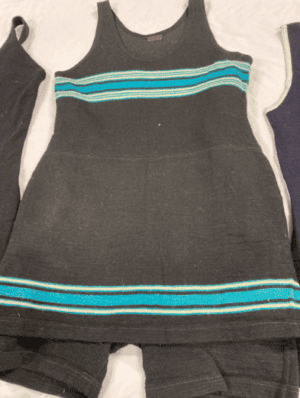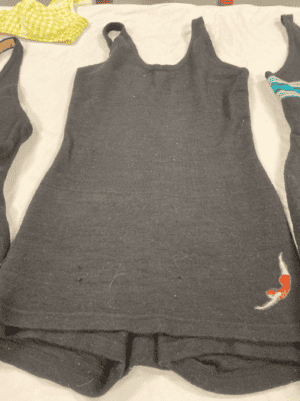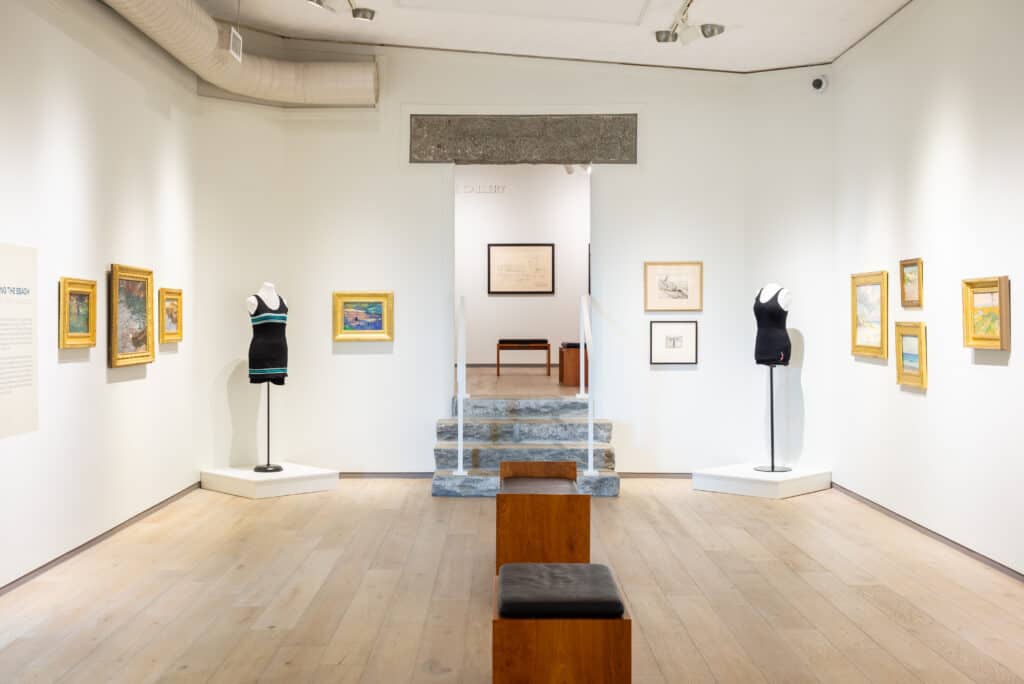A Short History of Bathing Attire
By Lizzie Hand
OMAA is fortunate to have a dynamic intern program, which gives the opportunity for talented undergraduate scholars to learn more about the curatorial field and museum work. We’d like to highlight scholarship by interns that supplements the exhibition Shifting Sands.
This time of year, department stores roll out swimsuits in assorted styles, patterns, and colors, whetting our appetites for the aspirational spring vacation on a warm beach as we melt out of winter hibernation and prepare for the warmer New England months. We now take for granted the garments that allow us to freely engage in summer fun, but swimwear hasn’t always been so accessible or varied. Bathing costumes and swimsuits became a new category of popular attire with the steady rise of beach culture in the nineteenth and twentieth centuries in Europe and the United States. Swimming wasn’t widely considered a leisure activity until the nineteenth century (that is, for men, it was the twentieth century before it was accepted as a leisure activity for women) and bathing took place where nudity was not a concern in the privacy of one’s home, or at a bathhouse segregated by gender. However, modernization led to a growing number of people with free time and disposable income. With increased accessibility to more efficient transportation and circulating ideas about water and fresh air as “cures” to the strife of living in an increasingly industrialized modern world, urbanites were drawn to beaches and seaside resorts. This placed beachgoers in quite the predicament: what to wear? How could you maintain a respectable appearance and attire in the setting of rocks, sand, wind, and water?
Late eighteenth and early nineteenth century bathing costumes for women were modeled after chemise-style undergarments. Historians cite examples of flannel bathing gowns with lead weights sewn into the hem to avoid having the dress balloon once the wearer entered the water. As the decades went on, the style became more sophisticated and by the mid-nineteenth century bathing costumes followed dressmaker conventions. The ankle length, loosely cut dress of heavy wool fabric with full sleeves was now worn with pantaloons underneath, belted at the waist, finished at the wrist with ruffles, and worn with a high collar, full stockings, and shoes. If all of this seems like it would pose a hindrance, just add water! The picture of style…and comfort? Wearers lamented the bathing costume of the era because of its unattractiveness and cumbersome nature when wet. The outfit was outright dangerous to wear while swimming and only practical as a fabric barrier that protected the wearer from both the cold and sun. It also “protected” wearers from the prying eyes of onlookers in the propriety-and-modesty-obsessed social environment of the time. And though the bathing costume was excessively modest by today’s standards, it was still perceived as inappropriate attire for a public setting. Bathing machines, small changing huts on wheels, were an invention used to shield bathers from being seen by others in their bathing costumes, particularly in the mixed company of men and women. The horse-drawn machine was wheeled to the water’s edge where the person inside could emerge to dip in the water. Then, to avoid the embarrassment of a passerby seeing a wet bathing costume clinging to the body, the bather could hop back in the machine and be wheeled back to higher ground to change into everyday dress.
The production around bathing machines aside, the beach, in many ways, became a place where ideas about respectability could be loosened a bit for the sake of fun and socialization. Mixed bathing and swimming between men and women was common in the United States far earlier than in Europe, where bathing and swimming remained segregated by gender until the early twentieth century. A small number of daring American women adopted a European-style bathing costume of pantaloons worn with a tunic-style shirt, but overall, American bathing costume was more modest due to the popularity of mixed bathing. Nonetheless, women were eager for a pared-down costume and, by the late nineteenth century, the popular style had short sleeves that puffed up around the shoulders, a knee length skirt, and a sailor collar. This was worn with stockings, shoes and a hat or oiled silk or canvas cap to protect long hair. Men were also expected to dress somewhat modestly at the beach, though athletics had long been accepted as a suitable endeavor for men and men’s swimwear was modeled on athletic garb: a knitted short-sleeved or tank-style tunic top with trunks hemmed slightly above the knee.
To illustrate the difference of the experience of the beach as it relates to attire and gender, I look to Charles Woodbury’s Opposite Narrow Cove (fig 1, date unknown) and Bernard Karfiol’s Boys and Boats (fig 2, c. 1916). Woodbury’s painting depicts a group of four women in bathing costumes. Woodbury observes the calm scene from a distance, the shore scene dotted with the women’s red bathing caps. They remain on or very close to the shore, wading up to their knees only, restricted from going further due to both societal expectations around acceptable feminine behavior and their constraining dresses. On the other hand, Karfiol shows a group of men boating, diving, and swimming, almost on top of one another. He gets in the center of the dynamic action and paints up close, focusing on the bodies and movement. The men wear either singlet style swimsuits or nothing at all. They are completely unrestricted by their attire.

Figure 1. Charles Woodbury, Opposite Narrow Cove (date unknown).

Figure 2. Bernard Karfoil, Boys and Boats (c. 1916).
Women longed for this type of physical activity and freedom and continued to push the boundaries of social expectations by engaging in swimming and athletics. These activities gained greater acceptance for women by the turn of the century, and with this grew the demand for a more practical outfit, a swimsuit versus the more complicated bathing costume of years past. The Australian swimming and diving superstar Annette Kellerman is credited with helping to popularize the one-piece tank-style knitted suit in the United States. She traveled internationally putting on fancy diving shows and strongly advocated for this style of suit as it allowed for full range of movement and therefore was far safer and more comfortable to swim in than any other bathing suit in existence. First visiting the United States in 1910 with her show, Kellerman shocked audiences with her daring style, to a positive end. As scandalous as she may have been considered by some, she was also seen as physically fit, glamorous, and beautiful, an aspirational figure to many young women who aimed to replicate the style of the “bathing beauty.” The early 1900s also saw companies like Jantzen Knitting Mills mass producing and selling one-piece knit swimming suits with tank-style tops and attached trunks. The one-piece was accessible and, finally, allowed for some freedom to show skin, to move, and to swim.
The knit one-piece was the dominant swimsuit style by the 1920s for both men and women. Many swimsuits produced at this time were virtually indistinguishable from one another based on gender were it not for the models in advertisements wearing said suits. Maine Historical Society has a wonderful small collection of this style of swimsuit (fig. 3-4).


Figure 3. Black Bathing Suit with Aqua Stripes, 1920-1930. Collections of Maine Historical Society. Portland, Maine. (Photograph by Donna Cassidy)
Figure 4. Black Swimming Suit, 1921. Collections of Maine Historical Society. Portland, Maine. (Photograph by Donna Cassidy)
The androgynous style reflected the political and social climate of the time as women pushed for equal rights and greater independence in daily life. During the early 1920s women still wore stockings and belts as additions to their one-piece suits for a “feminine” touch, but by the end of the decade these accessories were no longer seen as necessary or fashionable. By the 1930s, men could bear their chests at the beach without harassment from beach monitors who had long kept watch over beachgoers to assure proper decorum, which, for a long time, included specifications on appropriate swimsuits. Skin was in and, with new options in swimsuit fashion, so was the suntan. Hollywood stars of the era with their glamorous lifestyles and daring fashions were trendsetters and inspired audiences to be bold and daring themselves by wearing new and ever-changing swimsuit styles and patterns. Advances in stretch and water-resistant fabric in the 1930s and 1940s such as Lastex and Rayon made this possible and suits became more structured and form-hugging while retaining freedom of movement. Suits with cut-outs and halter necks, two pieces, and even strapless suits were all the rage.
Despite greater acceptance of more revealing swimsuits, the navel-bearing bikini, introduced in France in the 1940s, was not widely adopted in the United States until the 1960s. Perhaps this is not so surprising given Americans’ previous resistance to adopting more progressive fashions, but, in line with previous cycles of fashion, the bikini couldn’t be avoided for long. It remains one of the most popular styles of women’s bathing suits to this day. More skin-baring swimsuit styles allowed women the freedom of physical movement but also to express bodily autonomy and even sensuality in a public setting deemed appropriate by society. This freedom is, of course, complex. More revealing styles of bathing suits paired with the ever-present male gaze are linked with an increase in self-scrutiny among women leading to unhealthy or even harmful behaviors such as food restriction.
The beach, like all modern social spaces, is a site that was and continues to be experienced differently based on one’s identity – gender expression, class, race, age, ability, and so on. What we wear on our bodies is such a large part of how our identity is expressed, whether this is a conscious choice on the part of the wearer or not. I spent a lot of time last summer as an intern for Shifting Sands thinking about how drastically a garment can influence the way that we experience different activities and spaces. Through my research surrounding the history of bathing costumes, I was able to explore what life may have been like for men and women of centuries past as they navigated the simultaneous freedom and constraints that the beach presented.



